Read and download free pdf of CBSE Class 8 Science Cell Structure and Functions Assignment. Get printable school Assignments for Class 8 Science. Class 8 students should practise questions and answers given here for Chapter 8 Cell Structure And Functions Science in Class 8 which will help them to strengthen their understanding of all important topics. Students should also download free pdf of Printable Worksheets for Class 8 Science prepared as per the latest books and syllabus issued by NCERT, CBSE, KVS and do problems daily to score better marks in tests and examinations
Assignment for Class 8 Science Chapter 8 Cell Structure And Functions
Class 8 Science students should refer to the following printable assignment in Pdf for Chapter 8 Cell Structure And Functions in Class 8. This test paper with questions and answers for Class 8 Science will be very useful for exams and help you to score good marks
Chapter 8 Cell Structure And Functions Class 8 Science Assignment
INTRODUCTION
A cell is the structural and functional unit of life. It is the building block of which all living organisms are made, and the smallest unit of life capable of all the living functions. It is defined as a mass of protoplasm bounded by a plasma membrane.
Cell vary in size. Most cells are very small (microscopic), some may be very large. Some cells may exist as independent units of life. Some such cells like Euglena and Amoeba can change their shape, but most cells have a fixed shape. The number of cells vary from organism to organism. An amoeba is single-celled, while a human body weighing about 60 kg may have as many as 60 × 1015 cells. In unicelluar organisms, e.g. Amoeba, Paramoecium or Chalamydomonas, all the basic functions of a living being are performed in one cell, while multicellular organisms have well-developed division of labour. So, their different functions are performed by different organs. For example, we have a stomach to digest food, a heart to pump blood and a brain to think.
An English scientist, Robert Hooke, discovered the cell in 1665 while examining thin sections of cork under his simple microscope. He observed a mass of hexagonal chambers like a honeycomb and called them(compartments) cells. Cell is the Latin word for 'a little room'.
DISCOVERY OF CELL
1. Robert Hooke (1665) :– An English man and first curator of Royal society of London.
Observed a thin transverse section of bark of a tree under self designed microscope.
He noticed honey - comb like compartments.
Cork section shown in
Robert Hooke's Microscope
He coined the term cell.
He wrote a book - Micrographia.
He actually observed dead cells.
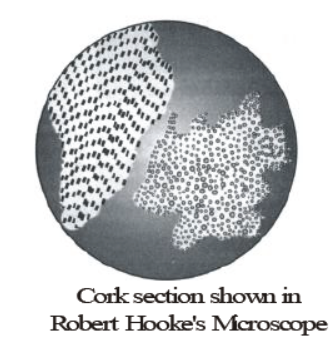
2. Antony Van Leeuwenhoek (1674) was first to observe living cells like bacteria [from tartar of teeth] erythrocytes [fish], sperms and protozoans [eg. Vorticella]
3. N. Grew (1682) :– Proposed cell concept which states that cell is unit of structure of organisms.
4. Rudolf Virchow (1858) :– Proposed that new cells formed from the pre-existing cells.
MICROSCOPE
A microscope is an instrument to view small objects by magnifying them. It enables us to see the different types of living cells and the structures they contain.
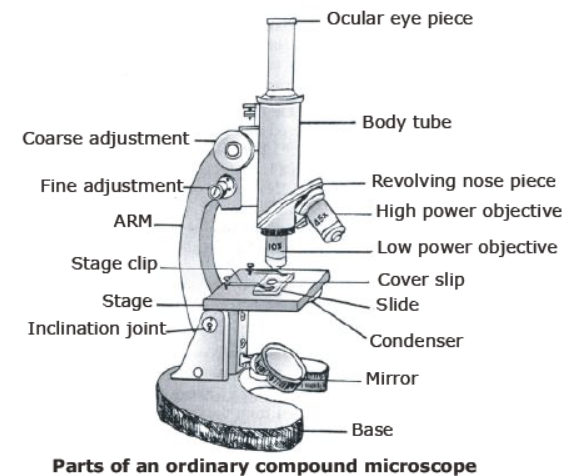
TYPES OF MICROSCOPES
There are mainly three types of microscopes. They are :
- Light microscope : The light microscope uses light to produce images.
-Transmission Electron Microscope (TEM) : The electron microscope was designed by Knoll & Ruska (1932). A TEM makes use of a beam of highly energetic electrons to examine objects. The image produced is of a very fine scale.
- Scanning Electron Microscope (SEM) : Like the TEM, the SEM also uses electrons to produce images.
In the case of a SEM, electrons are reflected off the surface of the specimen, because of which SEM images usually manage to capture the physical features of a cell in great detail.
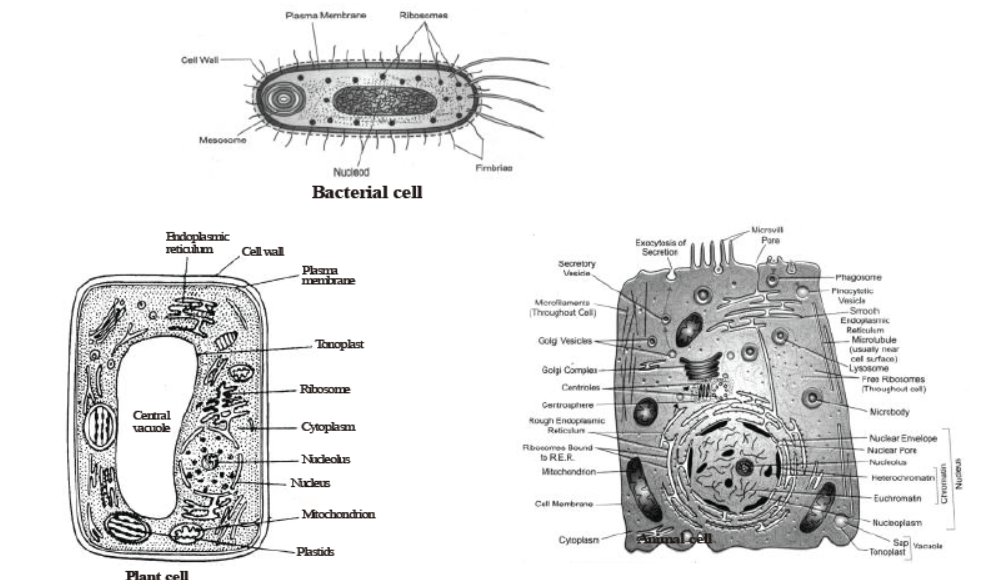
STRUCTURE OF A CELL
- Cell membrane or plasma membrane:
A cell is essentially a tiny 'bag' of living matter. The covering of this 'bag' is called the cell membrane or plasma membrane. It maintains the shape and size of the cell and protects its contents. It acts like a sentry-allowing only some things to enter and leave the cell and stopping others. For example, it allows oxygen and nutrients to pass into the cell and lets wastes pass out of it. This is why it is called selectively permeable.
- Cell wall:
Plant cells have an additional protective wll called the cell wall. It is thick, rigid and permeable, and is made up of a carbohydrate called cellulose.
- Cytoplasm :
The matter inside the cell mebrane is called cytoplasm. It consists of a jellylike fluid with various structures, such as the nucleus, floating in it. These structures are called organelles.Salts, proteins, sugar and other substances are dissolved in the fluid.
- Nucleus:
Almost every cell has a nucleus. Red blood cells are among the exceptions. The nucleus is the largest and the most important organelle of the cell. It is usually spherical or oval in shape.Inside it there are thread like structures called chromosomes. Nucleus is the controlling central cell. Chromosomes have genes arranged in a linear fashion.
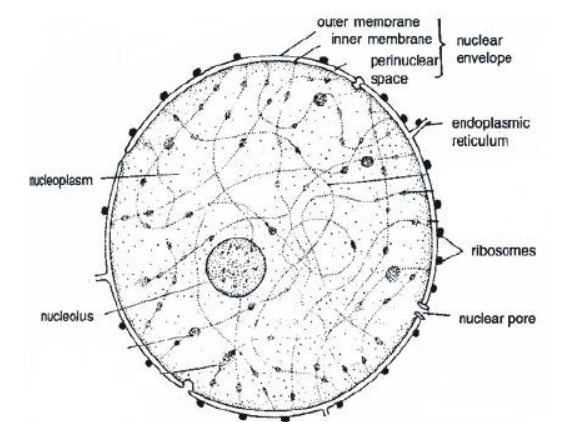
It is the most important part of the living cell.
It is usually spherical or oval in shape.
It controls all the vital functions of the cell.
It has four components:
(i) Nulcear Membrane (ii) Nulceoplasm
(iii) Nulceolus (iv) Chromosomes
(i) Nuclear membrane: Surrounds the nucleus and separates it from the cytoplasm. It is permeable and controls the passage of materials between cytoplasm and nucleoplasm
(ii) Nucleoplasm: The part of protoplasm which is enclosed by nuclear membrane is called nucleoplasm. It contains chromatin threads and nucleolus.
(iii) Nulceolus: It is a spherical body in the nucleus. It is composed of RNA and is responsible for protein synthesis.
(iv) Chromosomes: Nucleus contains thread like structures called chromosomes.
The hereditary units of chromosomes are the genes. They are responsible for the transmission of characters from parents to the offsping.
Nucleus along with tis role in inheritance regulates and controls differeny metabolic activities of the cell.
On the basis of well organised nucleus, cells can be of two types
(i) Prokaryotic cell (ii) Eukaryotic cell
(i) Prokaryotic cells: These are cells having primitive nucleus without nuclear membrane.
Organism with primitive nucleus are known as prokaryotes.
Ex. Bacteria and blue green algae.
(ii) Eukaryotic cells: These are cells having a well organised nucleus with nuclear membrane.
Organsims with true nucleus are known as eukaryotes.
Ex. Man, elephant, onion.
- Vacuoles:
The central part of most plant cells is occupied by a large vacuole. You may have noticed it in some of the plant cells you observed. It is a sac like structure filled with fluid. Food, wastes pigments and other substances are dissolved in the fluid. Some plant cells have a number of large vacuoles.
Vaculoes are not so common in animal cells. When they ocour, they are much smaller in size.
- Plastids:
These organelles are not present in animal cells. Chloroplasts (a type of plastid) contain the green pigment chlorophyll and are responsible for photosynthesis. Only green parts of plants have chloroplasts.
There are two other types of plastids called chromoplasts and leucoplasts. Chromoplasts contain pigments which give fruits and flowers their colours. Leucoplasts store food and are found in the storage organs of plants.
- Endoplasmic reticulum (ER)
The endoplasmic reticulum is a network of tube-like structures running through the cytoplasm.
If ribosomes are attached to it, the reticulm is rough, otherwise it is smooth.
Function - It gives internal support to the colloidal matrix (cytoplasm).
Rough endoplamic reticulum (RER) is associated with the synthesis of proteins.
- Ribosomes
Ribosomes are extremely amall, round bodies found either in the state in the cytoplasm or
attached to the surface of the ER. They are composed of ribonucleoprotein (ribonucleic acid and
protein).
Functions - The main function of ribosomes is to act as a platform or work place for the synthesis of proteins.
- Mitochondria
Mitochondria are small, rod shaped organelles found in large numbers. Each mitochondrion is bounded by two membranes-outer and inner. The outer membrane is smooth and the inner membrane is pushed inwards at intervals forming crests called cristae. The cristae lie in a ground substane called matrix. Mitochondria process enzymes necessary for the oxidation of carbohydrates. This process releases energy in the form of ATP. This is why mitochondria are known as the powerhouses of the cell. Mitochondria have their own DNA and ribosomes. They can synthesize their own proteins and thus they are semiautonomous organelles. Function- Mitochondria provide energy for the vital activities of living cells.
- Golgi body
They store, modify, package and condense the proteins synthesized in the ribosomes.
- Lysosomes
These saclike, small spherical, single membrane-bound vesicles contain enzymes. These enzymes are synthesized in the RER, which are brought to the Golgi complex. Lysosomes are formed by the Golgi complex. They occur in animal cells and in the meristematic cells of a few plants. Function- They help in breaking down (digesting) large molecules of the cell. They work in defence againt bacteria and viruses. During stavation, lysosomes act on their own cellular organelles and digest them. This results in cell death. Hence lysosomes are called suicide bags or demonlition squads.
- Centrioles
The centrosome is a distinct region of the cytoplasm close to the nucleus of animal cells. It usually has two central granules called centrioles. The centrioles are hollow, cylindrical structure made of microtubules arranged in a specific manner. They are arranged at right angles to each other.
Function- At the time of cell division, centrioles move to the poles and form spindle fibre which help in the movement of chromatids (daughter chromosomes) in the daughter cells. They help in the formation of cilia and flagella.
- Movement of subtances across the cell membrane
- Diffusion:
Diffusion is the process of mixing up or different substances due to the random motion of their component atoms, molecules and ions. Diffusion takes place in solids, liquids and gases.
Ex. Burning of incense stick.
- Osmosis:
Diffusion of water across a semipermeable membrane is called Osmosis. The movement of water in living beings depends on osmosis. The movement of water molecules across the cell membrane is affected by the amount of solute dissolved in it. Here also the water molecules are free to pass across the membrane in both directions. But the net movement of water molecules takes place from the dilute solution to the concentration one, i.e., from the region of greater concentration of water towards the region of lower concentration of water.
Ex. Grains in water.
- Plant Tissues
Plant tissue are basically of two types-meristematic and permanent. This differentiation is based on the ability of the mature cells of the tissue to divide and produce new cells. Meristematic tissue cells are capable of dividing, while permanent tissue cells are not.
- Meristematic Tissue
This tissue consists of actively dividing cells and is present in the growing regions of plants, e.g., the tips of roots and stems. The cells can be round, oval, polygonal or rectangular, but there are a few things they have in common. They are packed closely without intercellular spaces, have thin cellulose walls, dense cytoplasm and prominent nuclei. Vacuoles are almost absent in such cells because they are completely filled with sap. Depending on the region of the plant where it is present, meristematic tissue can be of three types- apical, lateral and intercalary.
Apical (from apex) meristem, as the name suggests, is present at the growing tips of stems and roots. Apical meristem is primary meristem.
Lateral meristematic tissue occurs along the sides of the cental (longitudinal) axis of the plant.
It gives rise to vascular tissues.
Intercalary meristem occurs at the base of leaves or internodes. These cells grow fast and soon change into permanent tissues.
- Permanent Tissue
The division and differentiation of the cells of meristematic tissues given rise to permanent tissues. Cell division is the formation of two or more daughter cells from one mother cell. Simple permanant tissue consist of similar permanent cells that perform the same function or a similar set of functions. Parenchyma, collencyma and sclerenchyma are three types of simple permanent tissues. Complex permanent tissue are a group of different types of cells that perform a common function. Xylem and phloem are two types of complex permanent tissue.
- Parenchyma
This tissue is composed of large, thin-walled cells which are generally oval or spherical. The cells are not packed closely, i.e., there are intercellular space. These living cells with a nucleus and a vacuole are found in the soft parts of the plant. They store food, fill up spaces between other tissue and provide temporary support to the plant. When they contain chloroplasts, as in leaves, they help manufacture food.
- Collenchyma
This tissue is composed of cells that are elogated and thickened with cellulose at the corners. There is no intercellular space. Collenchyma provides mechnical support to plant organs and is found in leaf stalks and below the epidermis of stems. It helps leaves and stems bend without breaking. It provides support, protection and flexibility ot plant organs. It is generally absent in roots.
- Sclerenchyma
This tissue is composes of long, narrow cells whose walls are evenly thickened with lignin. Lignin is a chemical that acts like cement, sticking fibres and hardening them. Sclerenchyma cells are dead. They are packed together closely, and provide strength and flexibility to plant parts. They are present in stems, veins of leaves, the hard covering of seeds and nuts, and the husk of coconut. Fibre-yielding plants like jute and flax contain this tissue in abundance.

- Xylem
Xylem, or wood, as it is often called, is a complex tissue. The cells are thick-walled, tubular and often dead. This tissue has four types of cells– tracheids, vessels, xylem parenchyma and xylem fibres. Of these only tracheids and vessels transport sap.
- Phloem
Phloem too is a complex tissue made up of four types of cells, or elements–sieve tubes, companion cells, phloem fibres and phloem parenchyma. It is not necessary for the phloem to contain all four types of cells. Phloem to contain all four types of cells. Phloem cells are living cells (except phloem fibres) which help transport food from leaves to the storage organs and growing regions of the plant.
- Animal Tissues
While doing the activities in this chapter, you have come across two types of animal tissue, the cheek cells are a type of epithelial tissue, while blood is a kind of connective tissue. There are two other types of animal tissue–muscular and nervous.
- Epithelial Tissue:
This tissue covers the surface of the body and lines the internal organs. Its main function is protection. The cells that form the different types of epithelial tissue differ in shape. Some are thin and flat, some cubelike, while others are columnar.
- Connective Tissue:
Blood, bones cartilages, tendons (which connect muscles with bones) and ligaments (which tie bones together) are diferent types of connective tissue. Adipose tissue, or what is generally known as fat, is also a kind of connective tissue. Though different in structure, connective tissues have one thing in common-the cells are suspended or embedded in a matrix. In blood, the matrix is liquid and is called the plasma.
- Muscular Tissue:
Muscular tissue is also of different types. However, the different types of muscular tissue (or muscles) have the same basic functoin. They contract and relax to make different parts of the body move. The muscles in our arms, legs thighs, back and so on help us move. The muscles in the heart help it pump blood. The muscles in the alimentary canal help the passage of food. The muscles in the blood vessels help them dilate and get constricted.
- Nervous Tissue:
Nerve cells make up nervous tissue. A nerve cell has a long tail and short branches coming out of it.The tail too has branches. These help to carry message from one cell to the other. The brain and spinal cord are make up of nervous tissue.
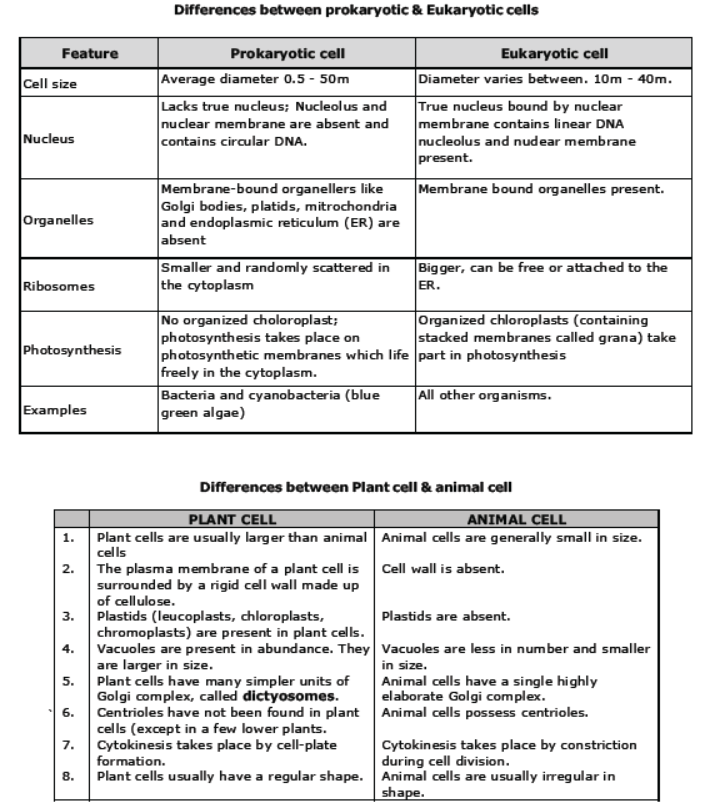
MCQs
Question. Blood is a type of
(A) Epithelial tissue
(B) Connective tissue
(C) Nervous tissue
(D) Muscular tissue
Answer. B
Question. The covering of an animal cell is:
(A) Cell wall
(B) Cell membrane
(C) Nuclear membrane
(D) Cytoplasm
Answer. B
Question. Organisms lacking a nucleus and membranebound organe celles are called:
(A) Diploid
(B) Haploid
(C) Prokaryotes
(D) Eukaryotes
Answer. C
Question. Relatively large vacuoles are present in:
(A) all prokaryotes
(B) all eukaryotes
(C) Plant cells
(D) Animal cells
Answer. C
Question. The growth of cells is regulated by
(A) mitochondrion
(B) vacuole
(C) nucleus
(D) Golgi complex
Answer. C
Question. The centriole is associated with:
(A) DNA synthesis
(B) cell division
(C) Circulation
(D) respiration
Answer. B
Question. Proteins are formed in the:
(A) Golgi complex
(B) mitochondria
(C) plastids
(D) ribsosomes
Answer. D
Question. The name suicide bag has been given to:
(A) Centroiles
(B) Ribosome
(C) Mitochondrion
(D) Lysosome
Answer. D
Question. Genes are located on the:
(A) Nuclear membrane
(B) Chromosomes
(C) Lysosomes
(D) Cell membrane
Answer. B
Question. Gaseous exchange in plants takes place through:
(A) epidermal cells
(B) stomata
(C) stem
(D) vascular tissue
Answer. B
Question. When a cell is placed in strong salt solution, it shrinks because:
(A) salt solution enters the cell
(B) cytoplasm of the cell begins to decompose
(C) water comes out of the cell to develop equilibrium
(D) all of these
Answer. C
Question. Tissue is defined as:
(A) group of similar cells having a common function
(B) different types of cells performing the same functions
(C) different types of cells performing different functions
(D) organised group of cells performing many functions
Answer. A
Fill in the blanks
1. Cell wall is found only in .............. cells.
2. Ribosomes are located on the surface of .............. .
3. All the components of a cell including the cell membrae is called .............. .
4. A true nucleus is absent in bacteria and .............. .
5. Two types of nucleic acids are .............. and............. .
Answer.
1. plant
2. endoplasmic reticulum
3. protoplasm
4. BGA (Blue green algae)
5. RNA & DNA
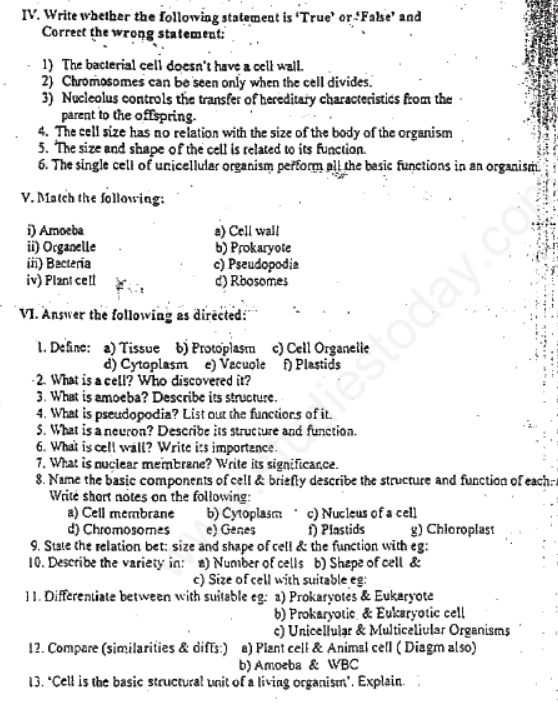
Fill in Blanks.
Question. Chloroplasts convert _____energy to _____ energy.
Answer : Chloroplasts convert solar energy to chemical energy.
Question. Vacuoles are the_____ sacs for solid or liquid contents.
Answer : Vacuoles are the storage sacs for solid or liquid contents.
Question. Mitochondria are _____ in RBCs.
Answer : Mitochondria are absent in RBCs.
Question. Golgi complex is the_____organ of the cell.
Answer : Golgi complex is the secretory organ of the cell.
Match the following.
a) Purple Carotene
b) Yellow Betalains
c) Orange Anthocyanin
d) Dark Pink Xanthophyll
Answer :
a) Purple Anthocyanin
b) Yellow Xanthophyll
c) Orange Carotene
d) Dark Pink Betalains
True or false.
Question. Cytoplasm is stable substance.
Answer : FALSE
Question. Cell walls are found around plants.
Answer : TRUE
Question. Rough ER has ribosome grannules on its outer surface.
Answer : TRUE
Question. Plasma membranes are fat, strong and rigid cell.
Answer : FALSE
Answer the following questions.
Question. State the difference between Isotonic solution and Hypertonic solution.
Answer : b) Isotonic solution - Hypertonic solution -
Medium outside and inside the The cell has more water
cell has same proportion of water, than the outside
water doesn’t go in or out. medium so water comes out of the cell.
Question. What happens to the agricultural waste after a few days when it is dumped in a compost pit ?
Answer : Lysosomes digest the waste.
Question. Explain the functions of endoplasmic reticulum ?
Answer : 1. It is the framework that supports cell.
2. Conduction of proteins.
3. Toxins that have entered the body through food, air and water are made water soluble by ER and then flushed out of the body.
d) Lysosomes digest the waste.
Question. What is the cell wall ?
Answer : Cell wall is an elastic and strong coat around cell membrane. It is mainly composed of carbohydrates like cellulose and pectin.
Answer any 2 questions in brief.
Question. Explain functions of Golgi complex ?
Answer : 1. Golgi complex is the secretory organ of the cell.
2. It modifies, sorts and packs materials synthesized in the cell (enzymes, mucus, proteins, pigments etc.) and dispatches them to various targets like plasma membrane, lysosome etc.
3. It produces vacuoles and secretory vesicles.
4. It helps in the formation of cell wall, plasma membrane and lysosomes.
Question. Difference between Eukaryotic cell & Prokaryotic cell.
Answer :
Eukaryotic Cell
Size - 5 - 100 micrometer Number of chromosomes Nucleus - with nuclear membrane, and nucleoplasm Mittochondria and plastids - present.
Examples-Present in highly evolved unicellular Bacteria and multicellular plants and animals.
Prokaryotic Cell - 1- 10 micrometer. Only one. Nucleoid resembling nucleus They don’t have membrance bound Bacteria
Question. What is vacuoles ?
Answer : Vacuoles are the storage sacs for solid or liquid contents They don’t have any typical shape or size. The structure of the vacuole changes according to the need of the cell. Vacuole is bound by single membrane.
Question. Explain functions of Lysosomes. is dumped in a compost pit ?
Answer : 1. Immune system - It destroys viruses and bacteria that attack the cell.
2. Demolition squads - It is destroys worn out cellular organelles and organic debris. (Autolysis)
3. Suicide Bags - When a cell becomes old or is damaged, lysosomes burst and enzymes digest their own cells.
4. During starvation, lysosomes digest stored proteins, fats.
VERY SHORT ANSWER TYPE QUESTIONS:-
1. Write true/false against the following statements:-
(a) Cells are invisible to the naked human eye
(b) Animal cells have a cellwall but plant cells do not.
(c) Protoplasm includes nucleoplasm & cytoplasm.
(d) Human cheek cells are irregular in shape.
(e) Cell wall is non-living & composed of cellulose.
2. How is cytoplasm different from cell sap?
3. What is the similarity between plasma membrane & egg membrane?
4. Identify the cell organelle/component-
(a) transparent jelly-like living substance
(b) kitchen of the cell
(c) brain of the cell
(d) heredity material
(e) provides various colours to plant parts
(f) unit of inheritance in living organisms
(g) organisms made of more than one cell
5. What is the difference in the location of the nuclei of plant & animal cells?
6. What is the importance of vacuoles in a cell?
7. What are prokaryotic cells?
8. Select the odd ones out giving reasons:-
(a) cheek cells, onion peel cells, bacterial cells, nerve cell
(b) blue green algae, hen's egg, neuron, ostrich's egg
9. Who discovered cell for the first time?
10. Name one cell organelle that is present in plant cells but absent in animal cells and another that is present in animal cells but absent in plant cells.
SHORT ANSWER TYPE QUESTIONS:-
1. Tabulate at least 4 differences between plant & animal cells.
2. If we remove the nucleus of a cell, write any 3 functions that will get affected.
3. "Cell is the smallest & basic unit of life".Justify the statement.
4. Compare Eukaryotic & Prokaryotic cells.Give examples as well.
5. Draw neat & labelled diagrams of the following:-
(a) human cheek cells
(b) onion peel cells
(c) typical plant cell
(d) typical animal cell
6. Giving examples explain the diversity in the shape & sizes of cells of organisms.
7. What are chromosomes?Where are they present & what is their function?
8. Classify the following organisms as unicellular & multicellular:-
bacteria, moulds, amoeba, entamoeba, mushroom, penicillium, paramecium, euglena, yeast, bracket fungus, rhizopus, spirogyra.
9. Name the 3 types of plastids & give their functions.
10. How are organs different from organelles?
11. Plant cells are more rigid in shape than animal cells.Why?
12. Chloroplasts are found only in plant cells.Why?
13. Cells are the basic structural units in living organisms.Explain.
LONG ANSWER TYPE QUESTIONS:-
1. Explain how cell division occurs in amoeba.
2. Explain how growth occurs in multicellular organisms.
3. Nucleus is extremely essential for a cell. Justify.
4. Identify the following wrt cells:-
(a) pigment necessary for photosynthesis
(b) structures present in cytoplasm
(c) living substance of the cell
(d) green plastids
(e) formed by collection of tissues
(f) units of inheritance present on chromosomes
(g) empty structure in cytoplasm
(h) a group of cells
(i) it separates the cell from the surrounding medium
(j) coloured plastids
I. Fill up the blanks:
1. The lens of the microscope close to the specimen placed on stage is called ___________.
2. A specimen is usually __________________ before being viewed.
3. ____________ are bean shaped cells, which regulates the opening of stomata.
4. Chromosomes carry ______________ which passes on hereditary characters.
5. The matrix in which blood cells are suspended is called _________________.
6. Cheek cells are ________________ cells
7. Cell wall is made up of a carbohydrate called _______________.
8. Various structures floating in cytoplasm are called ___________________.
9. Epidermal layers of root bears ______________.
10. Vascular bundle consists of thick walled cells called _______________.
I. Name the following :
1. Organisms made up of single cell.
2. Tissues forming vascular bundle.
3. These help to carry messages from one cell to other.
4. They contract and relax to make different parts of body moves.
5. Sac like structure filled with fluid.
6. Dense tangle of chromosome.
7. Disc shaped cells present in blood.
8. Algae with ribbon like chloroplasts zigzagging through it.
II. Give reasons for the following:
1. Plasma membrane is called selectively permeable.
2. Nucleus is called control room of cell.
3. Cell is called structural and functional unit of life.
III. Differentiate between the following:
1. Plant cell and animal cell.
2. Chloroplast and leucoplast.
3. Epithelial tissue and epidermal tissue.
4. Xylem and phloem.
5. Cell wall and cell membrane.
IV. Answer the following in brief:
1. Name two stains.
2. What are the different types of plastids and what do they do?
3. Name four types of animal tissues?
4. Why do we stain specimens before viewing them under microscope?
V. Draw well labelled diagram of the following :
1. Plant cell
2. Animal cell
3. Nerve cell
CBSE Class 8 Science Chapter 8 Cell Structure And Functions Assignment
We hope you liked the above assignment for Chapter 8 Cell Structure And Functions which has been designed as per the latest syllabus for Class 8 Science released by CBSE. Students of Class 8 should download and practice the above Assignments for Class 8 Science regularly. We have provided all types of questions like MCQs, short answer questions, objective questions and long answer questions in the Class 8 Science practice sheet in Pdf. All questions have been designed for Science by looking into the pattern of problems asked in previous year examinations. You can download all Revision notes for Class 8 Science also absolutely free of cost. Lot of MCQ questions for Class 8 Science have also been given in the worksheets and assignments for regular use. All study material for Class 8 Science students have been given on studiestoday. We have also provided lot of Worksheets for Class 8 Science which you can use to further make your self stronger in Science.
What are benefits of doing Assignment for CBSE Class 8 Science Chapter 8 Cell Structure And Functions?
a. Score higher marks: Regular practice of Science Class 8 Assignments for chapter Chapter 8 Cell Structure And Functions will help to improve understanding and help in solving exam questions correctly.
b. As per CBSE pattern: All questions given above follow the latest Class 8 Science Sample Papers so that students can prepare as per latest exam pattern.
c. Understand different question types: These assignments include MCQ Questions for Class 8 Science with answers relating to Chapter 8 Cell Structure And Functions, short answers, long answers, and also case studies.
d. Improve time management: Daily solving questions from Chapter 8 Cell Structure And Functions within a set time will improve your speed and accuracy.
e. Boost confidence: Practicing multiple assignments and Class 8 Science mock tests for Chapter 8 Cell Structure And Functions reduces exam stress.
How to Solve CBSE Class 8 Science Chapter 8 Cell Structure And Functions Assignment effectively?
a. Start with Class 8 NCERT and syllabus topics: Always read the chapter carefully before attempting Assignment questions for Class 8 Science Chapter 8 Cell Structure And Functions.
b. Solve without checking answers: You should first attempt the assignment questions on Chapter 8 Cell Structure And Functions yourself and then compare with provided solutions.
c. Use Class 8 worksheets and revision notes: Refer to NCERT Class 8 Science worksheets, sample papers, and mock tests for extra practice.
d. Revise tricky topics: Focus on difficult concepts by solving Class 8 Science MCQ Test.
e. Maintain notebook: Note down mistakes in Chapter 8 Cell Structure And Functions assignment and read them in Revision notes for Class 8 Science
How to practice CBSE Class 8 Science Chapter 8 Cell Structure And Functions Assignment for best results?
a. Solve assignments daily: Regular practice of Chapter 8 Cell Structure And Functions questions will strengthen problem solving skills.
b.Use Class 8 study materials: Combine NCERT book for Class 8 Science, mock tests, sample papers, and worksheets to get a complete preparation experience.
c. Set a timer: Practicing Class 8 Science Chapter 8 Cell Structure And Functions assignment under timed conditions improves speed and accuracy.
You can download free Pdf assignments for CBSE Class 8 Science Chapter 8 Cell Structure And Functions from StudiesToday.com
All topics given in Chapter 8 Cell Structure And Functions Science Class 8 Book for the current academic year have been covered in the given assignment
No, all Printable Assignments for Chapter 8 Cell Structure And Functions Class 8 Science have been given for free and can be downloaded in Pdf format
Latest syllabus issued for current academic year by CBSE has been used to design assignments for Chapter 8 Cell Structure And Functions Class 8
Yes, we have provided detailed answers for all questions given in assignments for Chapter 8 Cell Structure And Functions Class 8 Science

